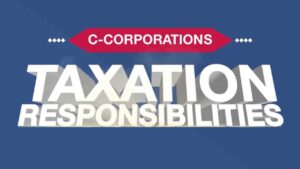How a C-Corp is Taxed
 C-Corps pay taxes at the corporate level first. After that, individual shareholders pay taxes on dividends paid by the corporation. This opens up certain shareholders to double-taxation.
C-Corps pay taxes at the corporate level first. After that, individual shareholders pay taxes on dividends paid by the corporation. This opens up certain shareholders to double-taxation.
The prospect of double taxation daunting, but it is an avoidable problem. Let’s examine how it works: First, a C-Corp doesn’t pay taxes on every dollar it earns. Rather, C-Corps deduct their operating expenses from their revenues, reducing the business’s taxable income. So if a company brought in $100,000 in revenue for a fiscal year but spent $65,000 in operating expenses, the taxable income of the business is $35,000, not $100,000.
Secondly, shareholders in a C-Corp only get taxed if dividends are distributed to them by the company. If a C-Corporation chooses not to provide dividends to shareholders and instead retain profits, double taxation is avoided since no dividends exist. In other words, only if a C-Corp makes a profit and distributes dividends to shareholders will double-taxation come into play.
All C-Corps are required to complete and return IRS Form 1120. This informs the IRS of your C-Corp’s income, gains, losses, deductions, credits and income tax liability.
If you’re not sure a C-Corp is right for you, feel free to contact us.
